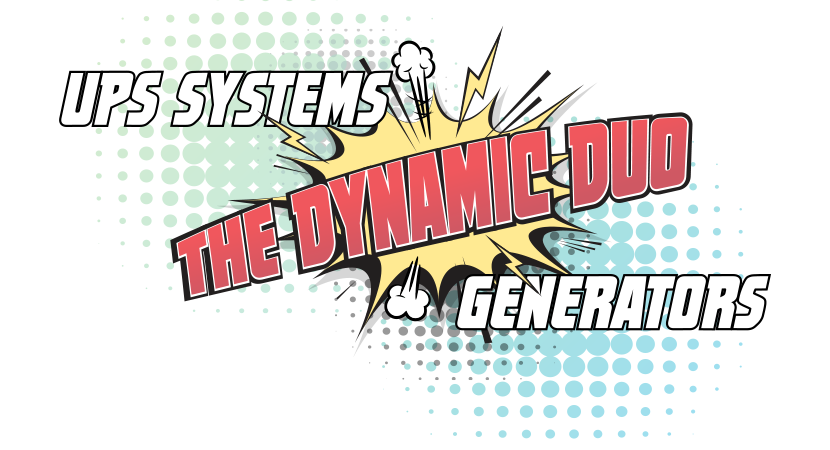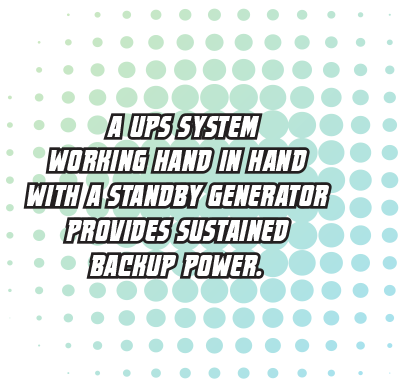The Dynamic Duo – UPS Systems Generators
As an ever-escalating list of threats leave today’s mission-critical environments even more vulnerable to downtime, a growing number of businesses are bolstering their level of security by combining a UPS with a backup generator.
Although UPSs offer an excellent line of defence against dirty power, data loss and equipment damage – as well as provide backup during short-term blackouts – they are not designed to deliver power indefinitely.
Enter the standby generator, an ideal complement for critical loads that must remain online 24/7 without interruption.
If a mains failure is detected, there is an inevitable time delay before the backup generator can be started up and synchronised. This delay results in a break of power to the critical load and therefore a standby generator cannot provide a complete backup power solution.
A UPS system working hand in hand with a standby generator provides sustained backup power. In the event of a mains power outage the UPS system protects the critical load by drawing power from its battery, then switching to generator power when available. It also uses backup generator power to recharge the depleted battery.
Similarly, the UPS system uses battery power to maintain an uninterrupted power supply during transfer back to mains, then uses the mains power to recharge its batteries again.
Size Matters
Generators are typically required to support air conditioning, emergency lighting, communications and other vital services in addition to the UPS. If the generator isn’t sized large enough, it won’t be able to hold voltage and frequency within the input tolerances of the UPS. Generally speaking, generators should be sized to:
- 1.2 x the nominal UPS capacity
- 3 x the nominal HVAC running capacity
- Allowance for other loads to be supported by generator
- Projected future growth
Fuel
The most common generator fuel options include, natural gas and diesel, each of which comes with its own set of own advantages and disadvantages. Natural gas-operating generators can be slower to respond and supply may be shut off in the event of an earthquake. Diesel is widely considered the best fuel though it has a short storage life and its cost can strain budgets.
In the move towards renewables, other generation options could be considered such as wind and solar however these do not provide an on-demand solution – e.g. a night-time generator demand could not be met with solar generation.
UPS Topology
The type of UPS will also impact UPS-generator compatibility and configuration, as not all can compensate for frequency variations without relying on the battery. Both standby and line-interactive UPSs use battery power to prevent frequency variations from affecting the protected load.
On the other hand, a double-conversion online UPS recreates the sine wave and filters frequency variations as part of its normal operation to preserve battery life. Because it constantly rectifies AC to DC and then inverts the DC back to AC, the online UPS produces an output that corrects for voltage and frequency deviations. For this reason, double-conversion technology is the most common for critical-load applications, and the most advantageous type of system for generator integration.
To help ensure you find the perfect match – and not an epic clashing of personalities – it is vital to configure the generator and UPS when deploying a standby generator as a second line of defence.
Generators must always be ready to start on demand, as mains power failures are unpredictable. Accordingly, they must always be kept warm, have a fully charged battery and sufficient fuel. They must be aware of mains failure and restoration status so that they can start and stop as appropriate.
This status information is usually supplied by signals from an Automatic Transfer Switch (ATS). ATSs are available in two designs; the traditional break before make or the modern seamless transfer. Both designs are suitable for UPS operation, however the seamless transfer will reduce the UPS battery usage and consequently increase battery service life.
Ensuring the generator can deliver a consistent output frequency is critical to its compatibility with the UPS. Every UPS has a set input voltage and frequency window that if exceeded, will cause the UPS to go on battery. If a generator’s frequency tolerance range is too wide for the UPS to accept, then the UPS may interpret the generator as an unstable power source. If this occurs, the UPS remains on battery permanently, which will ultimately cause the battery to deplete and drop the load.
Configuring the UPS to be alerted when the generator is running will ensure the UPS adjusts its input characteristics to be better suited to generator operation. This can reduce the initial and ongoing load on the generator during operation which improves generator run time and reduces fuel consumption.
Location Location Location
When installing a standby generator, it is important to consider the location and the impact of the generator. Fuel storage may be subject to regulation to prevent the fuel escaping into the environment or presenting a hazard.
Generators can also start and run at any time producing noise and heat. Consideration should be given to deploying the generator outdoors in a weatherproof, acoustic enclosure. The correct management of exhaust fumes is also essential, with care taken to ensure safe limiting and venting.


